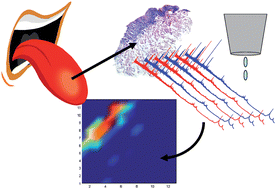Imaging mass spectrometry using chemical inkjet printing reveals differential protein expression in human oral squamous cell carcinoma
Abstract
Matrix-assisted laser desorption/ionization (

* Corresponding authors
a
Manchester Interdisciplinary Biocentre and School of Chemistry, The University of Manchester, 131 Princess Street, Manchester, UK
E-mail:
roy.goodacre@manchester.ac.uk
Tel: +44 (0) 161 3064480
b Shimadzu Biotech, Manchester, UK
c School of Dentistry and School of Medicine, University of Manchester, Oxford Road, Manchester, UK
Matrix-assisted laser desorption/ionization (

 Please wait while we load your content...
Something went wrong. Try again?
Please wait while we load your content...
Something went wrong. Try again?
S. A. Patel, A. Barnes, N. Loftus, R. Martin, P. Sloan, N. Thakker and R. Goodacre, Analyst, 2009, 134, 301 DOI: 10.1039/B812533C
To request permission to reproduce material from this article, please go to the Copyright Clearance Center request page.
If you are an author contributing to an RSC publication, you do not need to request permission provided correct acknowledgement is given.
If you are the author of this article, you do not need to request permission to reproduce figures and diagrams provided correct acknowledgement is given. If you want to reproduce the whole article in a third-party publication (excluding your thesis/dissertation for which permission is not required) please go to the Copyright Clearance Center request page.
Read more about how to correctly acknowledge RSC content.
 Fetching data from CrossRef.
Fetching data from CrossRef.
This may take some time to load.
Loading related content
